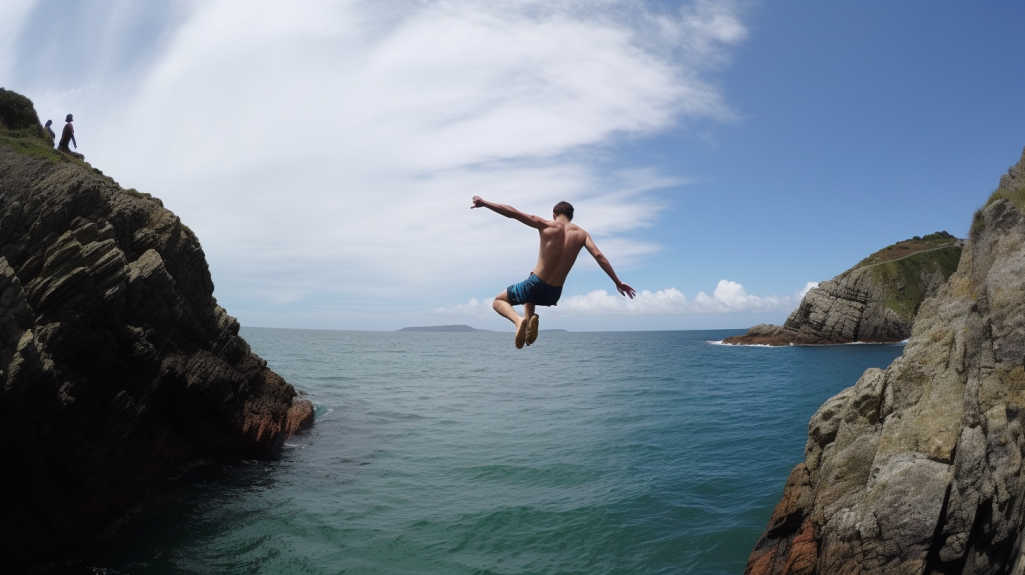Cliff jumping is an exhilarating outdoor activity that combines the thrill of free fall with the natural beauty of scenic landscapes. It’s a popular pastime for adventure seekers looking to add a dash of adrenaline to their outdoor experiences. However, cliff jumping can also be dangerous if not done with proper preparation and technique. In this comprehensive guide, we’ll explore the exciting world of cliff jumping while emphasizing safety and the essential techniques to ensure a thrilling yet secure adventure.
Understanding the Basics of Cliff Jumping
Know Your Location
Before embarking on a cliff-jumping adventure, it’s crucial to research and choose a safe and suitable location. Look for established cliff jumping spots with a good reputation among the local outdoor community. Popular cliff-jumping destinations often have well-maintained access points, clear water, and safe jump heights.
Assessing Water Conditions
Check the current water conditions before you jump. Water depth is the most critical factor. Ensure the water is deep enough to accommodate your jump safely. A general rule of thumb is that the water should be at least 10-12 feet deep, with no hidden rocks or debris beneath the surface. Avoid jumping into unfamiliar waters or during floods when conditions can be unpredictable.
Essential Safety Gear
Life Jacket
Wearing a life jacket is non-negotiable when cliff jumping. It provides buoyancy and can be a lifesaver if you encounter any unexpected difficulties while in the water. Make sure to choose a life jacket that fits snugly and comfortably.
Helmet
In some cliff-jumping scenarios, especially in rocky or turbulent waters, a helmet can be a valuable safety addition. It provides protection for your head in case of accidental collisions with underwater obstacles.
Footwear
Sturdy, water-resistant footwear with good grip is essential for navigating slippery rocks and ensuring a safe ascent and descent from your jumping point.
First Aid Kit
Carry a basic first aid kit to treat minor injuries, such as cuts and scrapes. It’s always better to be prepared, even for small emergencies.
Technique and Preparation
Warm-Up and Stretching
Just like any physical activity, cliff jumping requires a proper warm-up to prevent muscle strains and injuries. Spend a few minutes doing light stretches to prepare your body for the jumps.
Scouting and Assessing the Jump
Before you leap off a cliff, take the time to carefully scout your jump. Pay attention to the following:
- Water depth and conditions
- Any underwater obstacles or hazards
- The angle and height of the jump
- Wind direction and speed
Understanding these factors is crucial for making informed decisions and ensuring a safe landing.
Entry Techniques
There are several entry techniques for cliff jumping, each suitable for different heights and levels of experience:
- Pencil Dive: Ideal for lower jumps, this involves entering the water feet-first with your body straight and arms at your sides.
- Cannonball: A classic technique for intermediate jumps, where you tuck your knees to your chest and grab them with your arms before entering the water.
- Front Flip or Backflip: Advanced techniques for those comfortable with aerial maneuvers. These should only be attempted after gaining substantial experience.
Always start with lower jumps to build confidence and progress to higher ones gradually.
Maintain Proper Body Position
Maintaining the right body position while in the air is essential for a safe landing. Keep your body straight and streamline to minimize resistance. Point your toes and focus on a clean entry into the water. Avoid flailing your limbs, as this can lead to injury upon impact.
Group Safety
Buddy System
Never go cliff-jumping alone. Always bring at least one friend or companion who can assist you in case of an emergency. It’s also more enjoyable to share the experience with others.
Clear the Jump Zone
Before each jump, ensure the landing area is clear of other jumpers, swimmers, or any obstacles. Communicate with your group and establish a system for signaling when it’s safe to jump.
Environmental Considerations
Leave No Trace
Respect the natural environment by packing out all your trash and minimizing your impact on the surrounding area. Avoid disturbing wildlife and plants.
Check Local Regulations
Some areas may have specific rules and regulations related to cliff jumping. Research and comply with any local laws or guidelines to avoid legal trouble and protect the environment.
Building Skills and Confidence
Training and Practice
Improving your cliff-jumping skills takes time and practice. Start with lower jumps and progressively work your way up to higher cliffs as you gain confidence and experience. Consider taking lessons or seeking guidance from experienced cliff jumpers to refine your technique.
Mental Preparedness
Cliff jumping can be mentally challenging due to the fear associated with heights and the sensation of free-falling. Develop mental resilience through visualization, positive self-talk, and controlled breathing to manage anxiety and improve your performance.
Dealing with Emergencies
Despite taking precautions, accidents can happen. Be prepared for emergencies by learning basic water rescue techniques and having a plan in place. If you or someone in your group encounters trouble, remain calm, and seek help immediately.
Conclusion
Cliff jumping is an exhilarating outdoor activity that allows you to connect with nature while experiencing a rush of adrenaline. However, safety should always be a top priority. By following the guidelines and techniques outlined in this comprehensive guide, you can enjoy the thrill of cliff jumping while minimizing risks. Remember to choose suitable locations, wear the necessary safety gear, practice proper techniques, and respect the environment. With the right preparation, cliff jumping can be a safe and memorable adventure for outdoor enthusiasts of all levels.

